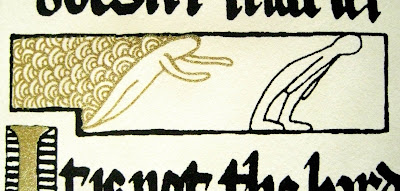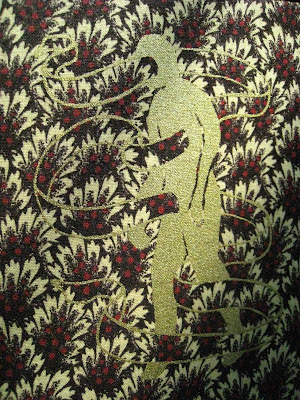
In the spring of 2007, in my Intro to Fibers class, I conducted my first experiment in beading in approximation of organic material.

I can't clearly remember, but I think that the only guidelines for our first assignment was that we had to bead or embroider something, and also incorporate felt. I never got around to the felt part, because beading an entire scroll takes a really, really long time.


To start, I took a 22'' x 30'' sheet of thick soft etching paper, roughly scored and tore it into strips about 3'' in width, painted in watercolor pale yellow lines down the length of the strips, laid them out on a wooden board, soaked them with water from my kitchen sink, and began scraping and hacking at the non-watercolored side of each strip until they had been satisfactorily decimated. I then stitched together the ends of each strip with a zippered blanket stitch, as well as sutured the most gruesome of my inflicted wounds.


After drying, I then attached old chopsticks I had covered in fabric to either end of the scroll, and began the decorative/decaying process of beading around the stitches and open holes in the paper.

I started at the left end and worked my way to the right, progressively darkening the color of the beads I was using, from whites, silvers, and yellow, through oranges and reds, and then to purple and black. I also increased the amount of beading, the spread of the mold.




The stitches that healed the paper were white, but the thread which bound the beads was gold. On the opposite side of the paper, you can see all of the stitching, and when the scroll is wound, the layers of beading and thread peek out.

I was thinking a lot about religion and spirituality that semester (as usual). I was interested in the boundaries between artificial and natural, and organic and inorganic, and the place that human religion and language take within those differences. What does it mean for us to worship documents created by our ancestors, and how does that practice compare to the worship of the natural world? When it is understood that all Bibles will eventually rot and turn to dust, all Torahs eaten by worms, and all our Qur'ans mold and disintegrate, what then is the highest power? As a species so inspired by beauty, we represent the holy in gold leaf and complex geometry; is there a better way? All of our most sacred documents are reproduced and represented in text. I find this to be limiting and unnessecary.
For class, I first suspended this piece, unfurled, in front of a light source, and then took it down to be laid on a long table. When light shows through the paper a completely new texture is revealed. You can see the ravaged fibers and the beads stand out like dark growths around the sutures and gaping holes.


























































